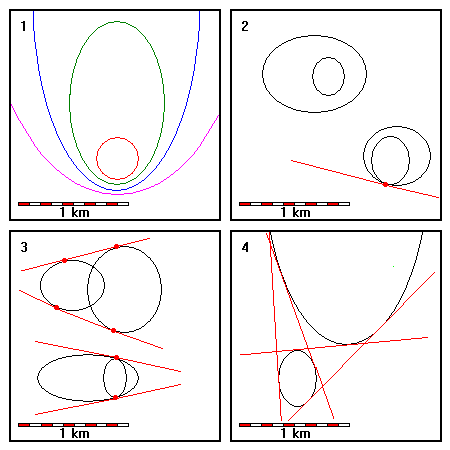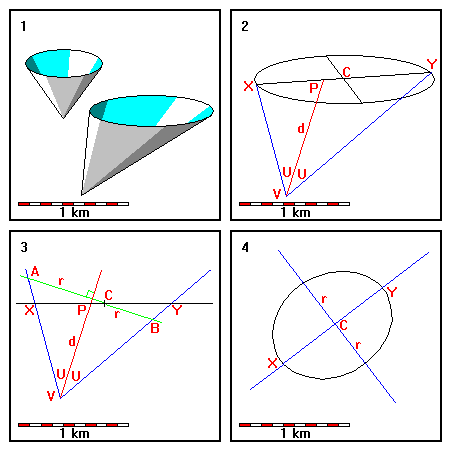Strike and Dip From Inclined Borehole Data
Steven Dutch, Professor Emeritus, Natural and Applied Sciences, University of Wisconsin - Green Bay
Often boreholes will be inclined. We will know the location of a sample along the hole and the angle a plane makes with the hole, but in this case, we will know neither the dip nor the strike.
Just as in the case of vertical boreholes, the possible orientation of the plane is tangent to each of two cones. The two cones have their apices at the sample locations and apical angles equal to 2U, where U is the angle the plane makes with each borehole. But now the planes are inclined, and their intersection trace with the surface will be an ellipse, a parabola, or a hyperbola. The major axis will always coincide with the trend of the borehole.
This construction is so complex it is usually better approached by computational methods or using a spherical projection, but the geometrical approach is presented here for completeness. This page merely sketches out how the problem can be approached graphically, because the problem is usually solved by computation or using a stereonet.
Generally speaking, it's better to refer the construction to some common datum plane rather than the topographic surface.
 |
1. Just as for vertical boreholes, the possible bedding planes lie on the surface of a cone. But since the cone has an inclined axis, it can cut the datum plane in a circle (red), ellipse (green), parabola (blue) or hyperbola (magenta).
2. Although the possible traces on the datum plane are conic sections, many of the same principles apply as with vertical boreholes. There may be no solutions or only one. 3. Intersecting traces yield two solutions. Some geometries (lower) are not possible with vertical boreholes. 4. Non-intersecting traces can have up to four solutions. However, two will be impossible because they require the bed to dip in two directions at once. In general, only the two pairs of external tangents are possible. |
If you're using real data but get no solution, there are a couple of possible reasons.
- You may have made an error or the data may be incorrect.
- If the data just barely fail to generate a solution, chances are a small recording or construction error is to blame and the best fit to the cone traces is the solution.
- There may be a structural discontinuity between the boreholes: fault, flexure or change in attitude.
- Geologic structures are rarely ideal planes either on a small or large scale. The intersection of the borehole and the bed may not accurately represent the overall geometry of the bed.
 |
1. Let's begin our discussion with the simplest case, where the cone is inclined steeply enough to cut the surface in an ellipse.
2. It is easy to see that AB is the major axis of the ellipse where the cone cuts the datum plane. It will have the same trend on the map as the borehole. If we can find the minor axis, we can draw the ellipse. We can easily find XY by drawing a cross-section in the plane of the borehole. Bisect the major axis to find the center of the ellipse. 3. A section through the cone (green) at right angles to the cone axis and bisecting the major axis will have a radius r equal to the minor axis. 4. With the axes plotted, construct the ellipse. |
Note in 2. that the borehole bisects the angle of the cone (of course) but it does not intersect the datum plane at the center of the ellipse.
Once the ellipse for one borehole is constructed, we can proceed similarly for the other borehole, construct the possible strike directions, then, using the depth information from the borehole intersections, find the dip.
The construction above is so involved (about the practical limit for graphical solution of a structural problem) that a computational approach is better.
Let the direction cosines of the two boreholes be (a1,b1,c1) and (a2,b2,c2), and let the direction cosines of the pole to the bedding plane be (ap,bp,cp). Now if borehole 1 intersects the bedding plane at angle U1, then the angle from the bedding plane pole to the borehole is 90-U1. So we have cos(90-U1) = a1ap + b1bp + c1cp. But cos(90-U1) = sin(U1). Call this s1. We have:
- s1 = a1ap + b1bp + c1cp, and similarly,
- s2 = a2ap + b2bp + c2cp
The known quantities are (a1,b1,c1) and (a2,b2,c2), the unknowns are (ap,bp,cp). It looks like we have two equations in three unknowns, but we don't. Direction cosines are related by a2 + b2 + c2 = 1. Let's rearrange the formulas to give:
- s1 - a1ap - b1bp = c1cp
- s2 - a2ap - b2bp = c2cp
Square both sides to get:
- s12 + a12ap2 + b12bp2 - 2s1a1ap - 2s1b1bp + a1apb1bp = c12cp2
- s22 + a22ap2 + b22bp2 - 2s2a2ap - 2s2b2bp + a2apb2bp = c22cp2
Note that c2 = 1 - a2 - b2, so we can write
- s12 + a12ap2 + b12bp2 - 2 s1a1ap - 2s1b1bp + a1ap b1bp = c12(1 - ap2 - bp2)
- s22 + a22ap2 + b22bp2 - 2s2 a2ap - 2s2b2bp + a2apb2bp = c22(1 - ap2 - bp2)
Grouping terms, we get:
- s12 - c12 + (a12 + c12 )ap2 + (b12 + c12)bp2 - 2 s1a1ap - 2s1b1bp + a1ap b1bp = 0
- s22 - c22 + (a22 + c22 )ap2 + (b22 + c22)bp2 - 2s2 a2ap - 2s2b2bp + a2apb2bp = 0
We can eliminate the remaining c terms by noting that c2 + a2 = 1 - b2 and c2 + b2 = 1 - a2 . So we get:
- s12 - 1 + a12 + b12 + (1 - b12)ap2 + (1 - a12)bp2 - 2 s1a1ap - 2s1b1bp + a1ap b1bp = 0
- s22 - 1 + a22 + b22 + (1 - b22)ap2 + (1 - a22)bp2 - 2s2 a2ap - 2s2b2bp + a2apb2bp = 0.
We now have two quadratic equations in two unknowns. Not exactly pretty, but certainly not insuperable, either. One approach to try would be pick a guess for ap, plug it into the equation and solve for bp. Plug this into the second equation and solve for ap (use a spreadsheet). If the solutions converge, fine. If not, try a different initial guess.
Return to Course Syllabus
Return to Techniques Manual Index
Return to Professor Dutch's Home Page
Created 27 August 2000, Last Update